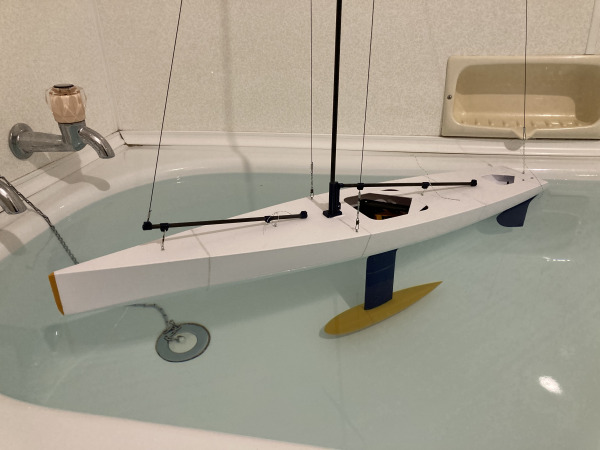3Dプリントの最新情報:自分だけのラジコンヨットを印刷しよう!
3Dプリントのレーシングスパローの設計プロセスは順調に進んでいます。最初のボートは海での試運転を行い、すぐに2隻目のボートが製作されました。
STLファイルの入手に興味がある方は、メールで info@racingsparrow.co.nz までご連絡いただき、待機リストに参加してください。
レーシングスパロー3Dは760mmの長さで、950mmの高さのマストと950gの鉛球を備えています。
この3Dプリントプロジェクトに関する以前のブログ記事をお読みください。
更新情報:STLファイルが利用可能になりました!

強力でスポーティなレーシングスパロー - 15ノットの突風で20ノット。
プロトタイピングの始まり
私はオレンジ色のボートP1から始めました。プロトタイプのための名前ですが、退屈ですね。P1は低風で短い帆走をしました。最初の印刷ボートとしては良い初帆でしたが、すぐに解決すべき問題がいくつかありました。主な問題は、高負荷エリアとキール周辺の強度でした。キール内部に2本の3mmのロッドを使用しましたが、1050gの球体を持つキールは非常にしなりやすかったです。デッキのサイドステイ取り付けポイントには、リグのテンションによる膨らみがありました。数週間、ガレージで完全にテンションがかかった状態で放置した結果、P1のデッキには大きなひびが入り、再び帆走すると沈む可能性があります。私はこのボートを保管して、私が経験したプロセスを思い出すためにしています。その後、白いP2を作りました。P2がとても気に入っています!
 3Dプリントされたマストとブームのフィッティング
3Dプリントされたマストとブームのフィッティング
うまくいったことの一つは、私が作ったリグです。マストとブームのためのすべてのフィッティングを設計し、印刷しました。マストは6mmのカーボンチューブ、ブームは5mmのチューブです。どちらも2mmの壁厚があります。私が設計したスプレッダーは非常に強力で、スーパーボンドで簡単に取り付けられます。これまでのところ非常にシンプルで頑丈です。P2ではスプレッダーの傾斜を調整し、マストの上部にステイとフォレスタイを取り付けて、マストのしなりを減らしました。また、このボートは一つのリグで済むように、マストを50mm短くしました。
 3Dプリントされたキールデザイン
3Dプリントされたキールデザイン
マストのサイズを縮小した理由の一つは、P2の球体の重さを100g減らしたからです。3Dプリントボートは、グラスファイバーやバルサに比べて本当に軽量なボートを作るのが難しいようです。妥協として、球体の重さを減らし、したがって帆面積も少し減らしました。また、キールを20mm後方に移動して、球体のバランスを改善し、キールのねじれを減少させました。P2では、キール内部のカーボンを3x(4x6)のカーボンストリップで強化し、キール内部に合計4x18mmのカーボンを使用しました。非常に強く、非常に剛性があります。今はキールと球体のデザインに非常に満足しています。重さは950gです。
3DプリントされたRCヨットの球体
球体は1.5mmのスキンで、2つの部分に分かれて印刷されます。2.5mmの鉛球を詰め、次に流動性のある樹脂を充填し、2つの部分をフランジで接合します。このデザインがシンプルで効果的であることに感激しています。球体は標準の鋳造球体よりもわずかに大きいだけです。また、仕様に合わせて正確な重さと形状を調整して構築することができます。従来はこれを達成するのがはるかに難しいです。

3Dプリントされた舵
P1では、元のレーシングスパローの設計に基づいて舵を作りましたが、問題なく機能しました。P2では、舵を大きく厚くしました。初心者のセーラーには、速度のわずかな違いでボートを操縦しやすくすると思います。P2は、強風の中でも非常に良く帆走します。舵はしっかりと印刷されたオブジェクトです。水面下に空気の空洞があると、鉛球の役割に影響を与え、無効にするため、空洞は避けるべきです。舵のポストには3mmのカーボンロッドを使用し、船体を通して印刷された穴を設けました。舵の内部には、強度を追加するために3/4の長さのカーボンロッドも入れています。これにより、帆走中にプラスチックが大きく折れるのを防ぎます。このカーボンポストのデザインは、これまで非常にうまく機能しています。
銀色の反射マイラー帆
帆については、クレイジーな銀色の反射素材に気づいたでしょう。これは、ニュージーランドでオンラインで購入できる最も安価な薄いマイラーフィルムの形態です。「トマト」栽培ショップから購入しました。1.2m幅の7.5メートルで24ドルです。これについては確信がありませんが、ニュージーランドのネルソンでテスト帆走を行った際に、いくつかのポジティブなコメントを受けました。この素材で約10〜15セットの帆を作ることができます!現在の私のニーズには最適で、構築と設置がうまくいきます。
 3Dプリントされたツイストハッチ
3Dプリントされたツイストハッチ
今日は、セーリングディンギーの検査ハッチに見られるようなメインハッチポートのツイストを試しました。昨日それをモデル化し、印刷して接着しました。ボートが大きな突風で完全に沈むような動きをしたときでも、水を防ぎました。ボートはその日の最大の突風で非常に強力でしたが、遊ぶのがとても楽しかったです。そして、大きな舵のおかげで、完全に操縦できました。ここでの主なポイントは、ハッチがテープを使わずに水を防いでくれたことで、非常に満足しています。これにより、毎回の帆走で水を防ぐことができるという自信が得られます。そして、すべてが完全に3Dプリントされています。

このプロジェクトの次は?
私はすでにP2を3回帆走させており、非常に良好な状態を保っています。強度に関する主要な問題をすべて解決し、今日15〜20ノットの風で帆走しましたが、うまくいきました。上り風では、非常に良く追跡しています。コントロールを完全に手放しても、自動的に帆走します。舵のデュアルレートを調整し、スイッチの切り替えで異なる動きを得られるようにしました。上り風では、小さな舵の動きだけで十分です。スムーズなラインを帆走するための良いトリックです。
しかし、P3はすでに建設中です!改善点のリストはかなり小さくなり、構築してテストする予定です。キールを10mm前方に移動し、球体を3mm後方に移動しました。私の写真を基に、前後のバランスをわずかに調整する必要があると感じています。フォレスタイの取り付けを20mm後方に移動して、リグのテンションを増しました。トップリグフィッティングにもう少し強度を加え、いくつかの小さな調整も行います。P2を帆走させ続け、A/Bテストに使用し、友人を連れて行って、他の人のボートを海賊のように沈めることができます!半分冗談ですが…楽しいでしょう。
P2を作るのにかかった費用
P2の白いボートを作るための部品とコストの内訳を以下に示します。
総コスト:材料費250NZD。すべての時間と素晴らしい3Dプリンターについては話さないでおきましょう!それはまったく別の話です。
30ドル PLA+ eSunフィラメント - いかなる3Dプリントショップ
17ドル 鉛球 - 銃器店(NZ)
5ドル マイラー銀色の帆素材 - ハーバルハウス
40ドル キール、マスト、ブーム、舵ポスト用のカーボン - フライトRC
4ドル スプリットピン - ミトレ10
10ドル ワイヤー、クリンプ、ブレイドライン - バーンズコマリン
27ドル スーパーボンドとアラルダイト5分エポキシ - ミトレ10
20ドル コロナセイルサーボ7Kg - ホビーキング
12ドル コロナ929MG舵サーボ2.2Kg - ホビーキング
16.50ドル 受信機HK-GT2防水 - ホビーキング
8ドル フタバ - セイルサーボアーム - RCNZ.com
15ドル フタバ - 4xAAバッテリーホルダー(フタバスタイルプラグ付) - RCNZ.com
4ドル SAB - ティラーアームシングル1/8シャフト - RCNZ.com
22ドル エネループプロAAx4バッテリー - pbtech.co.nz
30ドル その他雑費。
合計:250NZD
 しかし…良い3Dプリンターを探しているなら、私が使用しているのはCreality K1 Maxです。彼らは私をスポンサーしていませんが、お願いを断ることはありません。
しかし…良い3Dプリンターを探しているなら、私が使用しているのはCreality K1 Maxです。彼らは私をスポンサーしていませんが、お願いを断ることはありません。
このプリンターは、他のモデルより少し高価ですが、使用するのが本当に素晴らしいです。私はP1からこの3Dプリントに完全に新しいですが、この機械で問題はありませんでした。非常に信頼性が高く、使いやすいです。自動キャリブレーションを行い、信頼性の高いトラブルフリーの印刷ができ、設計と構築に時間を割くことができます。このモデルとこの構築技術を強くお勧めします。確かに、すべての人の好みに合うわけではありませんが、技術的な側面が好きで、できるだけ早くRCヨットを作りたいなら、これが最適です。
楽しい帆走と楽しい構築を!私はP3を作りに行かなければなりません!続報をお待ちください。そして、私は浴室を水浸しにしていません。